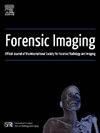解开两性二态性:马来西亚人群阿特拉斯(C1)骨的几何形态计量学分析
IF 1
Q4 RADIOLOGY, NUCLEAR MEDICINE & MEDICAL IMAGING
引用次数: 0
摘要
性别鉴定是法医人类学领域最关键的一步。传统的形态测量技术,包括基于卡尺的测量,通常是劳动密集型和耗时的。相比之下,几何形态测量法(GMM)提供了一种更有效的方法,基于生物形态的精确几何特征,将生物形态的定性和定量评估整合在一起。本研究旨在利用GMM评估颈椎侧位片上寰椎(C1)骨的性别二态性。采用横断面设计,利用413人的侧位颈椎x线片样本,包括208名男性和205名女性,年龄在35至45岁之间。使用TPSDig2 (Version 2.31)软件在数字化x线片上识别并标记6个二维地标。采用MorphoJ软件进行GMM分析。8个主成分(PC)占产生的形状变异性的100%。Procrustes方差分析显示,不同性别间质心大小和形状存在显著差异。判别函数分析(Discriminant function analysis, DFA)的分类正确率为87.9%,其中男性的识别正确率为87.0%,女性为88.8%。男性和女性在C1椎体高度p <上有显著差异;经独立t检验0.05。综上所述,GMM对C1椎体有明显的性别二态性,可作为体质人类学和法医学的替代方法。本文章由计算机程序翻译,如有差异,请以英文原文为准。

Unlocking sexual dimorphism: geometric morphometrics analysis of the Atlas (C1) bone in Malaysian populations
Sexual identification is the most crucial step in the forensic anthropology field. Traditional morphometric techniques, involving caliper-based measurements, are often labor-intensive and time-consuming. In contrast, the geometric morphometric method (GMM) offers a more efficient approach, integrating qualitative and quantitative assessments of biological forms based on precise geometric characterizations of their shape. This study aimed to assess sexual dimorphism of the Atlas (C1) bone on lateral cervical radiographs using GMM. A cross-sectional design was employed, utilizinglateral cervical radiographs from a sample of 413 individuals, including 208 males and 205 females, age ranged between 35 and 45 years old. Six 2D landmarks were identified and marked on the digitalized radiographs using TPSDig2 (Version 2.31) software. GMM analysis conducted by MorphoJ software. Eight principal components (PC) accounted for 100 % of the shape variability produced. Procrustes ANOVA showed that centroid size and shape were significantly different between different sexes. Discriminant function analysis (DFA) revealed a correct classification rate for 87.9 % of cases, with an identification accuracy of 87.0 % for males and 88.8 % for females. There were significant differences among males and females in the height of the C1 vertebral body with p < 0.05 via independent t-test. In conclusion, there was a significant sexual dimorphism of the C1 vertebra by GMM, which could serve as an alternative method in physical anthropology and forensic medicine.
求助全文
通过发布文献求助,成功后即可免费获取论文全文。
去求助
来源期刊

Forensic Imaging
RADIOLOGY, NUCLEAR MEDICINE & MEDICAL IMAGING-
CiteScore
2.20
自引率
27.30%
发文量
39
 求助内容:
求助内容: 应助结果提醒方式:
应助结果提醒方式:


